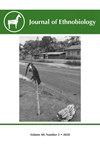Nuaulu Use and Management of Culturally Salient Polymorphisms in Codiaeum variegatum: Explaining the Biocultural Dimensions of Leaf Variegation in a Southeast Asian Ornamental
IF 2.9
3区 社会学
Q1 ANTHROPOLOGY
引用次数: 1
Abstract
Abstract. Codiaeum variegatum has become a well-known ornamental plant in Europe and North America and has long been culturally significant in Southeast Asia and the Pacific, for example as a boundary plant. This paper asks, firstly, how variations in foliage are classified, managed, and valued in one population (Nuaulu on the island of Seram, eastern Indonesia), and how this relates to the range of uses to which these variations are put. Secondly, the paper suggests that this particular case helps shed light on the importance of leaf variegation as an organoleptic quality in the context of biocultural evolution. It is noted that the features that evolved in its area of endemism are those making it attractive as an ornamental globally. While color variations in foliage combining genotypic cultivar differences, clonal differences, and age-dependent differences produce phenotypic instability and are a problem for ornamental plant producers in a commercial context, they are not a problem for Nuaulu.黄花蒿文化显著多态性的利用和管理:解释东南亚观赏植物叶片杂交种的生物栽培维度
摘要杂色鳕鱼已成为欧洲和北美著名的观赏植物,在东南亚和太平洋地区长期具有重要的文化意义,例如作为边界植物。本文首先询问了如何在一个种群(印度尼西亚东部瑟兰岛上的努奥卢)中对树叶的变异进行分类、管理和评估,以及这与这些变异的用途范围有何关系。其次,本文认为,这个特殊的案例有助于阐明在生物文化进化的背景下,叶斑作为一种感官品质的重要性。值得注意的是,在其特有地区进化出的特征使其成为全球具有吸引力的观赏植物。虽然叶片的颜色变化结合了基因型品种差异、克隆差异和年龄依赖性差异会产生表型不稳定性,这对商业环境中的观赏植物生产者来说是一个问题,但对Nuaulu来说不是问题。
本文章由计算机程序翻译,如有差异,请以英文原文为准。
求助全文
约1分钟内获得全文
求助全文
来源期刊

Journal of Ethnobiology
Social Sciences-Anthropology
CiteScore
4.80
自引率
3.40%
发文量
21
审稿时长
>12 weeks
期刊介绍:
JoE’s readership is as wide and diverse as ethnobiology itself, with readers spanning from both the natural and social sciences. Not surprisingly, a glance at the papers published in the Journal reveals the depth and breadth of topics, extending from studies in archaeology and the origins of agriculture, to folk classification systems, to food composition, plants, birds, mammals, fungi and everything in between.
Research areas published in JoE include but are not limited to neo- and paleo-ethnobiology, zooarchaeology, ethnobotany, ethnozoology, ethnopharmacology, ethnoecology, linguistic ethnobiology, human paleoecology, and many other related fields of study within anthropology and biology, such as taxonomy, conservation biology, ethnography, political ecology, and cognitive and cultural anthropology.
JoE does not limit itself to a single perspective, approach or discipline, but seeks to represent the full spectrum and wide diversity of the field of ethnobiology, including cognitive, symbolic, linguistic, ecological, and economic aspects of human interactions with our living world. Articles that significantly advance ethnobiological theory and/or methodology are particularly welcome, as well as studies bridging across disciplines and knowledge systems. JoE does not publish uncontextualized data such as species lists; appropriate submissions must elaborate on the ethnobiological context of findings.
 求助内容:
求助内容: 应助结果提醒方式:
应助结果提醒方式:


